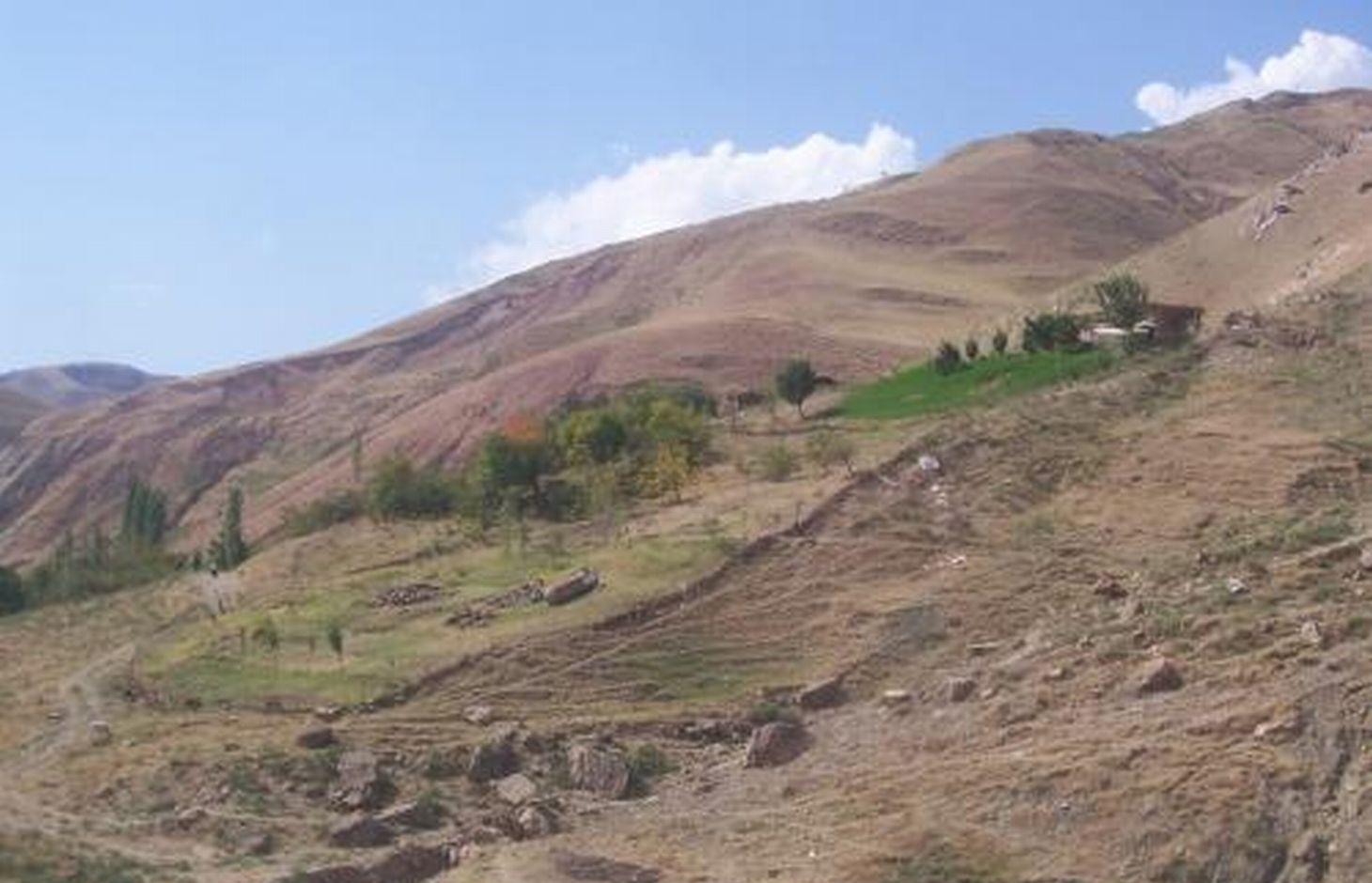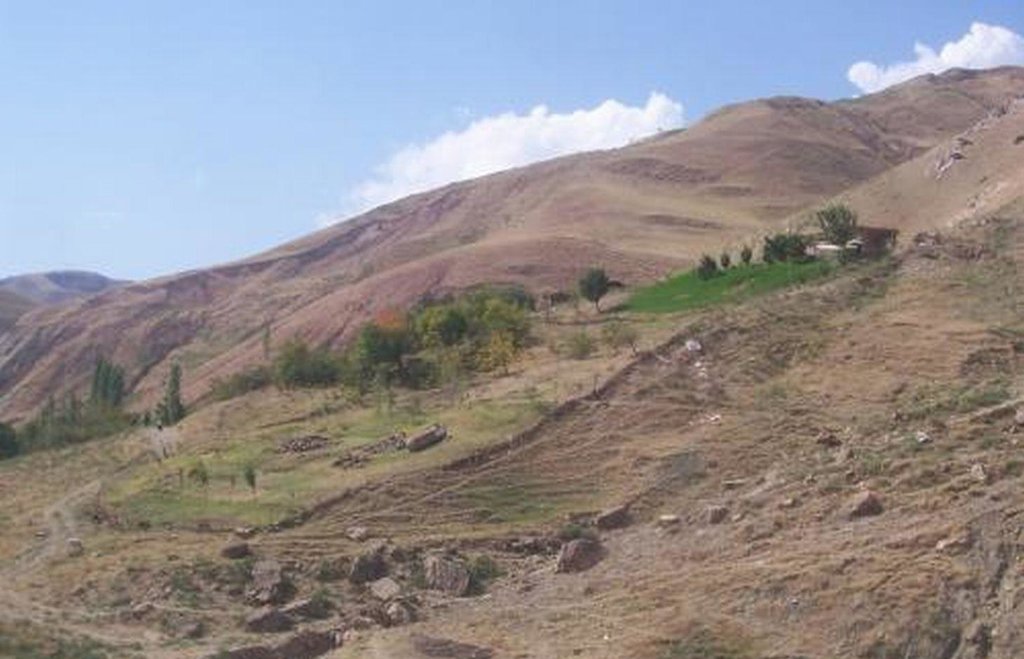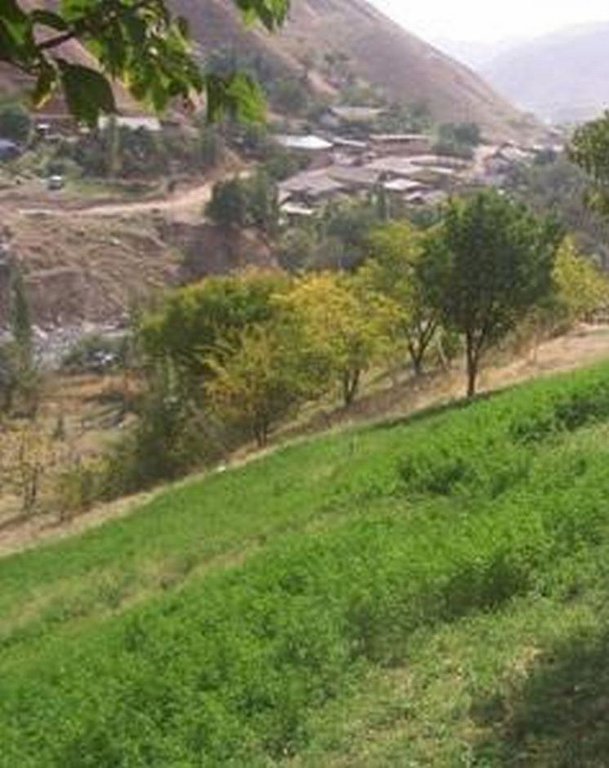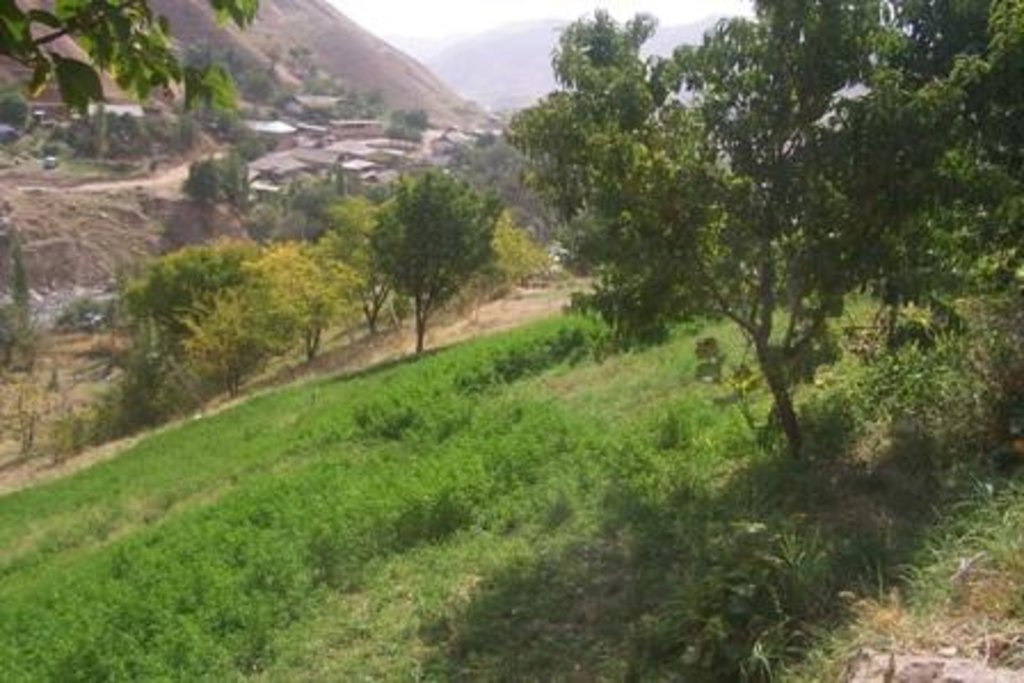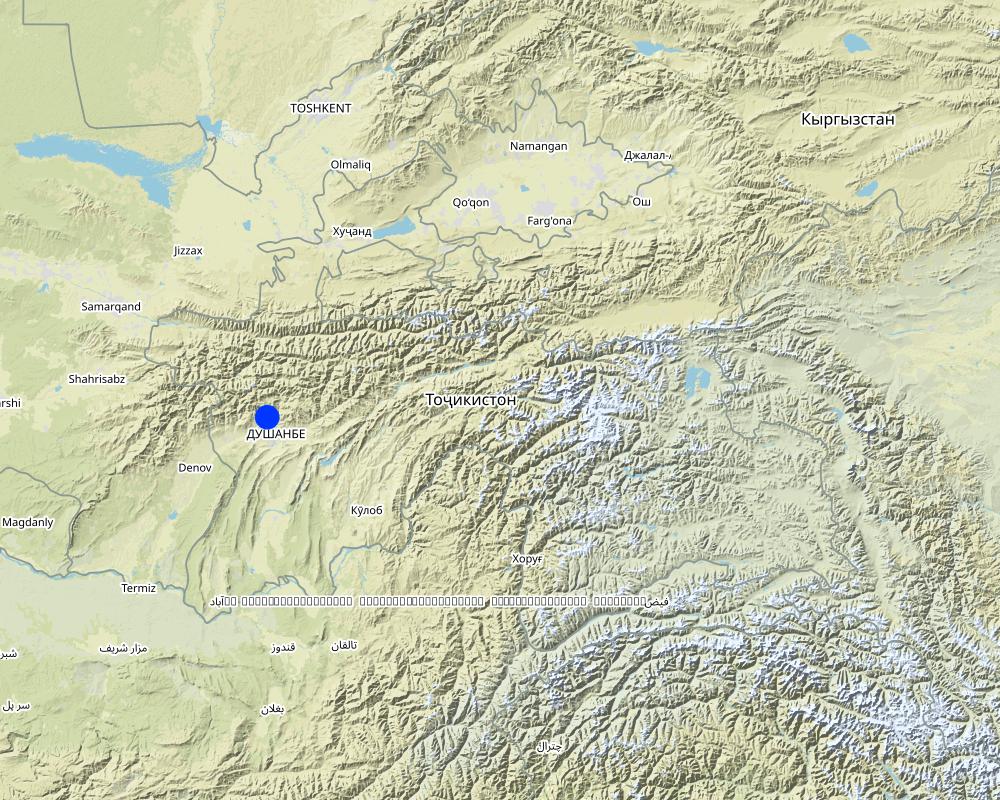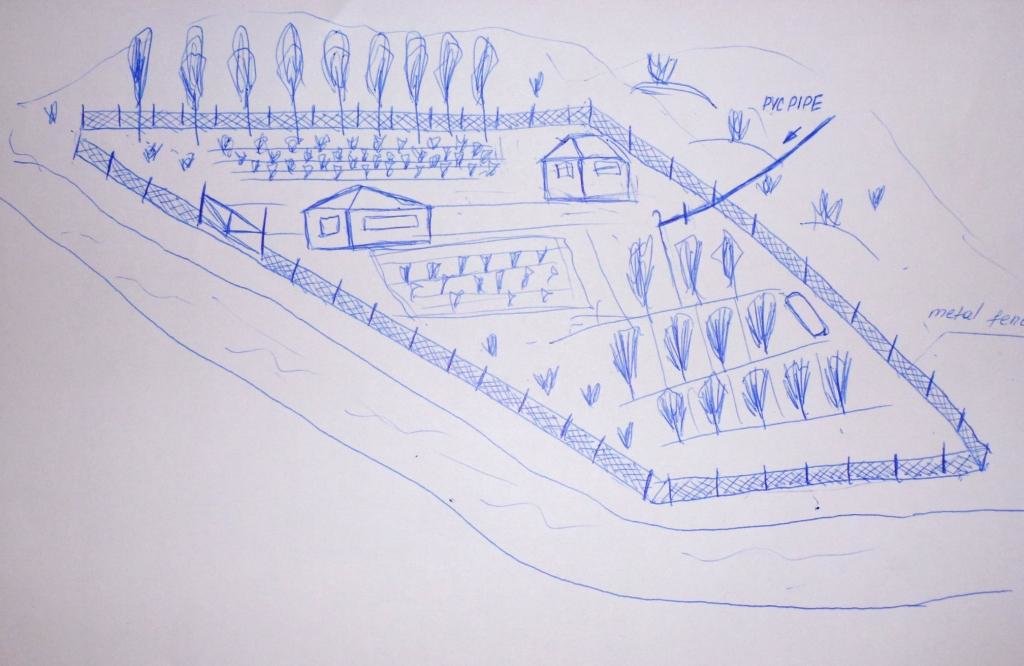Integrated Technologies for Household Plots [Tadjikistan]
- Création :
- Mise à jour :
- Compilateur : Habib Kamolidinov
- Rédacteur : –
- Examinateurs : Alexandra Gavilano, David Streiff, Joana Eichenberger
technologies_1057 - Tadjikistan
Voir les sections
Développer tout Réduire tout1. Informations générales
1.2 Coordonnées des personnes-ressources et des institutions impliquées dans l'évaluation et la documentation de la Technologie
Spécialiste GDT:
Nom du projet qui a facilité la documentation/ l'évaluation de la Technologie (si pertinent)
Pilot Program for Climate Resilience, Tajikistan (WB / PPCR)Nom du ou des institutions qui ont facilité la documentation/ l'évaluation de la Technologie (si pertinent)
GITEC/ADB/DMC Rural Development Project Land Management Institute - Tadjikistan1.3 Conditions relatives à l'utilisation par WOCAT des données documentées
Le compilateur et la(les) personne(s) ressource(s) acceptent les conditions relatives à l'utilisation par WOCAT des données documentées:
Oui
2. Description de la Technologie de GDT
2.1 Courte description de la Technologie
Définition de la Technologie:
A fenced enclosure transformed with stone clearing and a small scale irrigation system, to grow a wide range of perennial, annual and orchard crops, beekeeping and small scale animal production.
2.2 Description détaillée de la Technologie
Description:
A small area of previously severely eroded and almost devoid of vegetation area of land that was transformed through the building a perimeter fence, supplying a simple irrigation system and the planting of a diverse range of crops to provide a rich, integrated farming system. Activities then completed on this area included: orchard planting, perennial fodder crops (lucerne), garden vegetables, bee keeping for honey production and small scale animal rearing.
Purpose of the Technology: The farmer clearly stated that his prime, initial purpose in taking over this “ruined and abandoned land” was to improve and better guarantee the quality of his family’s lifestyle through enhanced and assured food and fodder production. He also recognised the potential for future profit through sale of his excess produce to market. Currently, the family has almost no need to buy food (and fodder) from nearby markets, apart from flour for bread making. This is a large cost saving. In hindsight, the farmer sees that he has dramatically improved land quality within the enclosure through mitigating erosion and increasing year-round vegetation cover.
Establishment / maintenance activities and inputs: The family (Enomali is the family name) first occupied this land in 1984. The first task was tree planting – a variety of orchard trees – on 0.1 ha of the current enclosure. This was fenced using abandoned wire and metal supports from old Russian factories. After nine family members left (to work in Dushanbe) the land user expanded the fence to the current 0.2 ha and continued to plant trees. He continued the stone removal through the 1990s and even up until the present day. Lucerne and vegetable gardens were initiated in the 1990s and continue to be enriched as required. Fodder, tree and vegetable production includes an ongoing set of tasks, as does the animal feeding with the home-grown fodder. Bee keeping is seasonal and the honey kept for home consumption. The land user continues to plant orchard trees every year and currently has more than 100. He gained a “certificate” of ownership” in 2008.
Natural / human environment: Before the family occupied this land, the land user stated that it was “totally ruined and abandoned”. That is why it was unoccupied. The family were prepared to work extremely hard to convert this ruined land to the green and productive “island” that it now is. The people in the area are dependent upon the produce of the land, however suitable land is in short supply and subject to population pressures.
2.3 Photos de la Technologie
2.5 Pays/ région/ lieux où la Technologie a été appliquée et qui sont couverts par cette évaluation
Pays:
Tadjikistan
Région/ Etat/ Province:
Central District of Tajikistan
Autres spécifications du lieu:
Varzob
Spécifiez la diffusion de la Technologie:
- répartie uniformément sur une zone
S'il n'existe pas d'informations exactes sur la superficie, indiquez les limites approximatives de la zone couverte:
- < 0,1 km2 (10 ha)
Commentaires:
The small area was all that the family could manage as there was an initial large workload, clearing stones and fence building, etc
Map
×2.6 Date de mise en œuvre de la Technologie
Si l'année précise est inconnue, indiquez la date approximative: :
- il y a entre 10-50 ans
2.7 Introduction de la Technologie
Spécifiez comment la Technologie a été introduite: :
- grâce à l'innovation d'exploitants des terres
Commentaires (type de projet, etc.) :
The land user developed the integrated approach to implentation of the technology.
3. Classification de la Technologie de GDT
3.1 Principal(aux) objectif(s) de la Technologie
- améliorer la production
- rehabilitate severely degraded land
3.2 Type(s) actuel(s) d'utilisation des terres, là où la Technologie est appliquée
Les divers types d'utilisation des terres au sein du même unité de terrain: :
Oui
Précisez l'utilisation mixte des terres (cultures/ pâturages/ arbres):
- Agroforesterie

Terres cultivées
- Cultures annuelles
- Cultures pérennes (non ligneuses)
- Plantations d’arbres ou de buissons
Cultures annuelles - Précisez les cultures:
- cultures fourragères - autres
- vegetables, orchard fruits, lucerne
Nombre de période de croissance par an: :
- 1
Précisez:
Longest growing period in days: 180Longest growing period from month to month: April to September

Pâturages
Pâturage intensif/ production fourragère :
- Affouragement en vert/ zéro-pâturage

Forêts/ bois
Produits et services:
- Fruits et noix
Commentaires:
Livestock density (if relevant):
< 1 LU/km2
Major land use problems (compiler’s opinion): Massive water erosion causing gullies, sheet washing and landslides. This leads to land denudation of the soil and vegetation. Almost total lack of soil organic matter and above/below ground biodiversity. No water holding capacity of the land – combination of steep slopes and no vegetation causes all rainwater to immediately runoff.
Major land use problems (land users’ perception): Same – the above words were used by the farmer in the on-farm interview.
Cut-and-carry/ zero grazing: Yes
Other type of forest: orchard species
Forest products and services: fruits and nuts
Future (final) land use (after implementation of SLM Technology): Mixed: Mf: Agroforestry
3.3 Est-ce que l’utilisation des terres a changé en raison de la mise en œuvre de la Technologie ?
Est-ce que l’utilisation des terres a changé en raison de la mise en œuvre de la Technologie ?
- Oui (Veuillez remplir les questions ci-après au regard de l’utilisation des terres avant la mise en œuvre de la Technologie)
Les divers types d'utilisation des terres au sein du même unité de terrain: :
Oui
Précisez l'utilisation mixte des terres (cultures/ pâturages/ arbres):
- Agroforesterie

Pâturages
Commentaires:
Grazing land: Ge: Extensive grazing land
3.4 Approvisionnement en eau
Approvisionnement en eau des terres sur lesquelles est appliquée la Technologie:
- mixte: pluvial-irrigué
3.5 Groupe de GDT auquel appartient la Technologie
- agroforesterie
- Amélioration de la couverture végétale/ du sol
- amélioration des variétés végétales, des races animales
3.6 Mesures de GDT constituant la Technologie

pratiques agronomiques
- A1: Couverture végétale/ du sol

pratiques végétales
- V1: Couverture d’arbres et d’arbustes

structures physiques
- S6: Murs, barrières, palissades, clôtures

modes de gestion
- M1: Changement du type d’utilisation des terres
Commentaires:
Main measures: agronomic measures, vegetative measures, structural measures
Type of agronomic measures: better crop cover, mixed cropping / intercropping, cover cropping, retaining more vegetation cover, furrows (drainage, irrigation)
Type of vegetative measures: in blocks
3.7 Principaux types de dégradation des terres traités par la Technologie

érosion hydrique des sols
- Wt: perte de la couche superficielle des sols (couche arable)/ érosion de surface
- Wg: ravinement/ érosion en ravines
- Wm: mouvements de masse/ glissements de terrain

dégradation biologique
- Bc: réduction de la couverture végétale
- Bh: perte d’habitats
- Bq: baisse de la quantité/ biomasse
- Bl: perte de la vie des sols
Commentaires:
Main type of degradation addressed: Wt: loss of topsoil / surface erosion, Wg: gully erosion / gullying, Wm: mass movements / landslides, Bc: reduction of vegetation cover, Bl: loss of soil life
Secondary types of degradation addressed: Bh: loss of habitats, Bq: quantity / biomass decline
Main causes of degradation: deforestation / removal of natural vegetation (incl. forest fires) (Post Soviet era – massive forest clearing for firewood), over-exploitation of vegetation for domestic use (Exploitation of fire wood.), overgrazing (massive overgrazing of an already depleted land resource), other natural causes (avalanches, volcanic eruptions, mud flows, highly susceptible natural resources, extreme topography, etc.) specify (Loess landscape – highly susceptible to water erosion – massively exacerbated by vegetation clearing (tree chopping and animal grazing))
Secondary causes of degradation: population pressure, poverty / wealth, war and conflicts (increased natural resource pressure during the civil war.)
3.8 Prévention, réduction de la dégradation ou réhabilitation des terres dégradées
Spécifiez l'objectif de la Technologie au regard de la dégradation des terres:
- restaurer/ réhabiliter des terres sévèrement dégradées
Commentaires:
Secondary goals: prevention of land degradation, mitigation / reduction of land degradation
4. Spécifications techniques, activités, intrants et coûts de mise en œuvre
4.1 Dessin technique de la Technologie
Spécifications techniques (associées au dessin technique):
The drawing shows an enclosed area, a fence line consisting of wire fencing, brush and scrap metal materials. At the top of the slope a row of fast growing poplars was planted to protect the enclosure and the adjacent vegetable plot from the wind and rain. Perenials are intercropped with fruit trees further below the dwelling and the area is fed by an irrigation pipe originating from a local spring.
Location: Tajikistan. Varzob, Luchob
Date: 28 April 2011
Technical knowledge required for field staff / advisors: moderate (If training was provided to replicate the technology.)
Technical knowledge required for land users: moderate
Main technical functions: control of raindrop splash, control of dispersed runoff: impede / retard, improvement of ground cover, improvement of topsoil structure (compaction), increase in nutrient availability (supply, recycling,…), increase / maintain water stored in soil, increase of biomass (quantity), promotion of vegetation species and varieties (quality, eg palatable fodder)
Secondary technical functions: increase of surface roughness, improvement of surface structure (crusting, sealing), increase in organic matter, increase of infiltration, water spreading, improvement of water quality, buffering / filtering water, reduction in wind speed, spatial arrangement and diversification of land use
Better crop cover
Material/ species: Perennial lucerne for fodder
Quantity/ density: 100% cover
Remarks: 0.1 ha
Cover cropping
Material/ species: Lucerne is a cover crop
Retaining more vegetation cover
Material/ species: Land previously bare
Agronomic measure: other
Material/ species: Perennial legume pasture species - lucerne
Quantity/ density: 0.1 ha
Furrows (drainage, irrigation)
Material/ species: Irrigation via hand cut 20cm cube ditches and poly pipe
Aligned: -contour
Vegetative material: T : trees / shrubs
Scattered / dispersed
Vegetative material: T : trees / shrubs
In blocks
Number of plants per (ha): 100%
Vertical interval between rows / strips / blocks (m): about 0.1 ha planted
Fruit trees / shrubs species: Apple, cherry, apricot, pear
Perennial crops species: lucerne
Other species: Vegetable garden
Slope (which determines the spacing indicated above): 38.30%
Gradient along the rows / strips: 5.24%
Wall/ barrier
Depth of ditches/pits/dams (m): 1
Length of ditches/pits/dams (m): 1000
Slope (which determines the spacing indicated above): 21 degrees – measured with cli%
Lateral gradient along the structure: 3 degrees%
Auteur:
Habib Kamolidinov, Land Management Institute, Giprozem 15, Dushanbe, Tajikistan
4.2 Informations générales sur le calcul des intrants et des coûts
autre/ monnaie nationale (précisez):
somoni
Indiquez le taux de change des USD en devise locale, le cas échéant (p.ex. 1 USD = 79.9 réal brésilien): 1 USD = :
4,5
Indiquez le coût salarial moyen de la main d'œuvre par jour:
5.50
4.3 Activités de mise en place/ d'établissement
| Activité | Calendrier des activités (saisonnier) | |
|---|---|---|
| 1. | Fence building | At the start |
| 2. | Irrigation pipes | At the start |
| 3. | Tree planting | At the start |
| 4. | Cover cropping (lucerne replanting) | annually |
| 5. | Small vegetable beds | annually |
| 6. | Vegetable garden | annually |
4.4 Coûts et intrants nécessaires à la mise en place
| Spécifiez les intrants | Unité | Quantité | Coûts par unité | Coût total par intrant | % du coût supporté par les exploitants des terres | |
|---|---|---|---|---|---|---|
| Main d'œuvre | Fence building | Persons/day | 100,0 | 25,0 | 2500,0 | 100,0 |
| Main d'œuvre | Tree planting | Persons/day | 10,0 | 25,0 | 250,0 | 100,0 |
| Main d'œuvre | Cover cropping | Persons/day | 5,0 | 25,0 | 125,0 | 100,0 |
| Main d'œuvre | Vegetable garden | Persons/day | 50,0 | 25,0 | 1250,0 | 100,0 |
| Matériel végétal | Trees | Pieces | 50,0 | 10,0 | 500,0 | 100,0 |
| Matériel végétal | Plants | Pieces | 3000,0 | 0,33333333 | 1000,0 | 100,0 |
| Matériaux de construction | Fence | meter | 200,0 | 2,25 | 450,0 | 100,0 |
| Matériaux de construction | Irrigation pipe | meter | 1500,0 | 1,5 | 2250,0 | 100,0 |
| Autre | Labour: Small vegetable beds | Persons/day | 20,0 | 25,0 | 500,0 | 100,0 |
| Coût total de mise en place de la Technologie | 8825,0 | |||||
| Coût total de mise en place de la Technologie en dollars américains (USD) | 1961,11 | |||||
Commentaires:
Duration of establishment phase: 48 month(s)
4.5 Activités d'entretien/ récurrentes
| Activité | Calendrier/ fréquence | |
|---|---|---|
| 1. | Better crop cover and cover cropping | Annually |
| 2. | Stone clearing | Annually |
| 3. | Vegetable garden | Annually |
| 4. | Animal husbandry (and bee keeping) | Annual |
| 5. | Fertilising (garden vegetables) | Annual |
| 6. | Tree planting | Annually |
| 7. | Lucerne reseeding | Annually |
| 8. | Vegetable planting | Annually |
| 9. | Small vegetable beds | Annual |
4.6 Coûts et intrants nécessaires aux activités d'entretien/ récurrentes (par an)
| Spécifiez les intrants | Unité | Quantité | Coûts par unité | Coût total par intrant | % du coût supporté par les exploitants des terres | |
|---|---|---|---|---|---|---|
| Main d'œuvre | Better crop cover and cover cropping | Persons/day | 10,0 | 25,0 | 250,0 | 100,0 |
| Main d'œuvre | Stone clearing | Persons/day | 10,0 | 25,0 | 250,0 | 100,0 |
| Main d'œuvre | Vegetable garden incl. fertilizing | Persons/day | 15,0 | 25,0 | 375,0 | 100,0 |
| Main d'œuvre | Animal husbandry (and bee keeping) | Persons/day | 40,0 | 25,0 | 1000,0 | 100,0 |
| Autre | Labour: Tree planting | Persons/day | 10,0 | 25,0 | 250,0 | 100,0 |
| Autre | Labour: Lucerne reseeding | Persons/day | 10,0 | 25,0 | 250,0 | 100,0 |
| Autre | Labour: Vegetable planting | Persons/day | 50,0 | 25,0 | 1250,0 | 100,0 |
| Autre | Labour: Preparing small vegetable beds | Persons/day | 20,0 | 25,0 | 500,0 | 100,0 |
| Coût total d'entretien de la Technologie | 4125,0 | |||||
| Coût total d'entretien de la Technologie en dollars américains (USD) | 916,67 | |||||
Commentaires:
Machinery/ tools: All work is done manually. There is one mule available to aid with carrying fodder and rocks., All works done manually. Mule assists with heavy lifting and carrying.
The area is approximately one hectare in total, however the costs are spread over a period of time up to 2010.
4.7 Facteurs les plus importants affectant les coûts
Décrivez les facteurs les plus importants affectant les coûts :
The human labour costs (I believe) are most misleading. The farmer and his family happily and willingly committed their time and effort over a period of 27 years to improving this piece of land – as they knew that their family lifestyle would vastly improve and be greatly assured through their efforts. As the farmer said during the interview: “What else would I be doing?” Meaning – this is his life and he thoroughly enjoyed the inputs, realising the richness of the outputs.
Fence costs were minimal (a few hundred dollars) as on departure of the Russians after the Soviet period, the factories were ransacked by locals for metals of all types, not a sustainable practice, but at this time gave locals access to free materials to use. In this case for fencing.
Trees – there was an initial set up cost and the farmer said he tries to plant at least 20 new trees each year to maintain and enhance productivity.
Lucerne – there was a set up cost (farmer forgets how much – but approx. $50) for seed. But now the lucerne is almost self-regenerating (from it's own seeds) as the last cut each year is for seed production that the farmer spreads in the lucerne field.
5. Environnement naturel et humain
5.1 Climat
Précipitations annuelles
- < 250 mm
- 251-500 mm
- 501-750 mm
- 751-1000 mm
- 1001-1500 mm
- 1501-2000 mm
- 2001-3000 mm
- 3001-4000 mm
- > 4000 mm
Spécifications/ commentaires sur les précipitations:
Dominate in Spring (March-May) The period June to September is very hot and dry (almost no rainfall)
Zone agro-climatique
- semi-aride
Thermal climate class: temperate
5.2 Topographie
Pentes moyennes:
- plat (0-2 %)
- faible (3-5%)
- modéré (6-10%)
- onduleux (11-15%)
- vallonné (16-30%)
- raide (31-60%)
- très raide (>60%)
Reliefs:
- plateaux/ plaines
- crêtes
- flancs/ pentes de montagne
- flancs/ pentes de colline
- piémonts/ glacis (bas de pente)
- fonds de vallée/bas-fonds
Zones altitudinales:
- 0-100 m
- 101-500 m
- 501-1000 m
- 1001-1500 m
- 1501-2000 m
- 2001-2500 m
- 2501-3000 m
- 3001-4000 m
- > 4000 m
Indiquez si la Technologie est spécifiquement appliquée dans des:
- situations convexes
Commentaires et précisions supplémentaires sur la topographie:
Altitudinal zone: The site is exactly at 1,180 meters a.s.l.
5.3 Sols
Profondeur moyenne du sol:
- très superficiel (0-20 cm)
- superficiel (21-50 cm)
- modérément profond (51-80 cm)
- profond (81-120 cm)
- très profond (>120 cm)
Texture du sol (de la couche arable):
- moyen (limoneux)
Matière organique de la couche arable:
- abondant (>3%)
Si disponible, joignez une description complète du sol ou précisez les informations disponibles, par ex., type de sol, pH/ acidité du sol, capacité d'échange cationique, azote, salinité, etc.
Soil texture: Loess soil – silty loam
Soil fertility is high with proper management (as in intervention) these soils are very fertile. Before the intervention –extremely low fertility
Topsoil organic matter was before intervention <1%
Soil water storage capacity is medium
5.4 Disponibilité et qualité de l'eau
Profondeur estimée de l’eau dans le sol:
5-50 m
Disponibilité de l’eau de surface:
bonne
Qualité de l’eau (non traitée):
eau potable
Commentaires et précisions supplémentaires sur la qualité et la quantité d'eau:
Availability of surface water was medium before the intervention.
Water quality (untreated) is good because the spring water is almost pure water.
5.5 Biodiversité
Diversité des espèces:
- moyenne
Commentaires et précisions supplémentaires sur la biodiversité:
But it will have improved with intervention through dramatically increased vegetation cover
5.6 Caractéristiques des exploitants des terres appliquant la Technologie
Orientation du système de production:
- subsistance (auto-approvisionnement)
Revenus hors exploitation:
- 10-50% de tous les revenus
Individus ou groupes:
- individu/ ménage
Niveau de mécanisation:
- travail manuel
- traction animale
Indiquez toute autre caractéristique pertinente des exploitants des terres:
Difference in the involvement of women and men: There is not a great difference. The farmer’s wife shares the workload but tends to focus more on the garden, fruit production, household duties and bee keeping. The farmer generally conducts hay cutting and gathering, stone removal, fence upkeep and animal tending (feeding and slaughtering when required).
Population density: < 10 persons/km2
Annual population growth: 1% - 2%
10% of the land users are average wealthy.
80% of the land users are poor.
10% of the land users are poor.
Off-farm income specification: The issue is that it tends to be the older and very young family members (ie Mr Enomali and his wife are in their late 50s, and their pre-school age grandchildren stay with them) stay on the farm. The others (18 to 50 yrs old) have paid employment in Dushanbe and Russia – and only visit the farm occasionally. However, it is believed they part-finance (contribute) to the upkeep of the family farm.
Market orientation of production system: All of the farm produce stays on the farm for home consumption, but they do eat well and very healthy (fresh and organic) food.
Level of mechanization: Normally manual but with one mule to help with heavy work.
5.7 Superficie moyenne des terres utilisées par les exploitants des terres appliquant la Technologie
- < 0,5 ha
- 0,5-1 ha
- 1-2 ha
- 2-5 ha
- 5-15 ha
- 15-50 ha
- 50-100 ha
- 100-500 ha
- 500-1 000 ha
- 1 000-10 000 ha
- > 10 000 ha
5.8 Propriété foncière, droits d’utilisation des terres et de l'eau
Propriété foncière:
- état
Droits d’utilisation des terres:
- individuel
Commentaires:
Not yet an issue – as he is the only one with access to the spring water.
5.9 Accès aux services et aux infrastructures
santé:
- pauvre
- modéré
- bonne
éducation:
- pauvre
- modéré
- bonne
assistance technique:
- pauvre
- modéré
- bonne
emploi (par ex. hors exploitation):
- pauvre
- modéré
- bonne
marchés:
- pauvre
- modéré
- bonne
énergie:
- pauvre
- modéré
- bonne
routes et transports:
- pauvre
- modéré
- bonne
eau potable et assainissement:
- pauvre
- modéré
- bonne
services financiers:
- pauvre
- modéré
- bonne
6. Impacts et conclusions
6.1 Impacts sur site que la Technologie a montrés
Impacts socio-économiques
Production
production agricole
Quantité avant la GDT:
0
Commentaires/ spécifiez:
Prior to the technology this land was “ruined, denuded wasteland” that had almost no carrying capacity, no productivity and no water supply, so the % increase as a result of the technology is from a starting point of zero.
production fourragère
Quantité avant la GDT:
0
qualité des fourrages
Quantité avant la GDT:
0
production animale
Quantité avant la GDT:
2
production de bois
Quantité avant la GDT:
0
risque d'échec de la production
Quantité avant la GDT:
0
diversité des produits
Quantité avant la GDT:
0
surface de production
Quantité avant la GDT:
0
gestion des terres
Quantité avant la GDT:
0
Disponibilité et qualité de l'eau
disponibilité de l'eau potable
Quantité avant la GDT:
0
disponibilité de l'eau pour l'élevage
qualité de l'eau pour l'élevage
disponibilité de l'eau d'irrigation
qualité de l'eau d'irrigation
Revenus et coûts
dépenses pour les intrants agricoles
Quantité avant la GDT:
0
revenus agricoles
Quantité avant la GDT:
0
diversité des sources de revenus
Quantité avant la GDT:
0
charge de travail
Impacts socioculturels
sécurité alimentaire/ autosuffisance
situation sanitaire
opportunités culturelles
possibilités de loisirs
connaissances sur la GDT/ dégradation des terres
situation des groupes socialement et économiquement désavantagés
Livelihood and human well-being
Commentaires/ spécifiez:
The primary aim of the farmer in introducing the Technology was to improve the family’s lifestyle and well being. He has easily achieved this and it seems to be getting better, year on year. The family have improved their food security and quality.
Impacts écologiques
Cycle de l'eau/ ruissellement
quantité d'eau
Quantité avant la GDT:
0
qualité de l'eau
Quantité avant la GDT:
0
récolte/ collecte de l'eau
Quantité avant la GDT:
0
ruissellement de surface
Quantité avant la GDT:
0
drainage de l'excès d'eau
Quantité avant la GDT:
0
évaporation
Quantité avant la GDT:
0
Sols
humidité du sol
Quantité avant la GDT:
0
couverture du sol
Quantité avant la GDT:
0
perte en sol
Quantité avant la GDT:
0
encroûtement/ battance du sol
Quantité avant la GDT:
0
compaction du sol
Quantité avant la GDT:
0
cycle/ recharge des éléments nutritifs
Quantité avant la GDT:
0
Biodiversité: végétale, animale
biomasse/ au dessus du sol C
Quantité avant la GDT:
0
diversité végétale
Quantité avant la GDT:
0
Autres impacts écologiques
Hazard towards adverse events
6.2 Impacts hors site que la Technologie a montrés
disponibilité de l'eau
Quantité avant la GDT:
0
flux des cours d'eau fiables et stables en saison sèche
inondations en aval
Commentaires/ spécifiez:
As the Technology has so revolutionised the productive capacity and sustainability of the site, there are no obvious disadvantages.
envasement en aval
capacité tampon/de filtration
dommages sur les champs voisins
6.3 Exposition et sensibilité de la Technologie aux changements progressifs et aux évènements extrêmes/catastrophes liés au climat (telles que perçues par les exploitants des terres)
Changements climatiques progressifs
Changements climatiques progressifs
| Saison | Augmentation ou diminution | Comment la Technologie fait-elle face à cela? | |
|---|---|---|---|
| températures annuelles | augmente | bien |
Extrêmes climatiques (catastrophes)
Catastrophes météorologiques
| Comment la Technologie fait-elle face à cela? | |
|---|---|
| pluie torrentielle locale | bien |
| tempête de vent locale | bien |
Catastrophes climatiques
| Comment la Technologie fait-elle face à cela? | |
|---|---|
| sécheresse | bien |
Catastrophes hydrologiques
| Comment la Technologie fait-elle face à cela? | |
|---|---|
| inondation générale (rivière) | pas connu |
Autres conséquences liées au climat
Autres conséquences liées au climat
| Comment la Technologie fait-elle face à cela? | |
|---|---|
| réduction de la période de croissance | bien |
6.4 Analyse coûts-bénéfices
Quels sont les bénéfices comparativement aux coûts de mise en place (du point de vue des exploitants des terres)?
Rentabilité à court terme:
négative
Rentabilité à long terme:
très positive
Quels sont les bénéfices comparativement aux coûts d'entretien récurrents (du point de vue des exploitants des terres)?
Rentabilité à court terme:
très positive
Rentabilité à long terme:
très positive
Commentaires:
The establishment and ongoing costs are very small in comparison to the long and short term benefits. If natural materials cannot be used for fencing materials, then the initial establishment costs will be higher.
6.5 Adoption de la Technologie
- cas isolés/ expérimentaux
Si disponible, quantifiez (nombre de ménages et/ou superficie couverte):
1 household
De tous ceux qui ont adopté la Technologie, combien d'entre eux l'ont fait spontanément, à savoir sans recevoir aucune incitation matérielle, ou aucune rémunération? :
- 91-100%
Commentaires:
100% of land user families have adopted the Technology without any external material support
There is a little trend towards spontaneous adoption of the Technology
Comments on adoption trend: There are (seemingly) quite a few enclosures already in this area – but these have not been reviewed.
6.7 Points forts/ avantages/ possibilités de la Technologie
| Points forts/ avantages/ possibilités du point de vue de l'exploitant des terres |
|---|
|
The land provided food security and a small income for my family. How can they be sustained / enhanced? To replicate it, maybe small grants and loans could be awarded. |
| Points forts/ avantages/ possibilités du point de vue du compilateur ou d'une autre personne ressource clé |
|---|
|
The fence building started and underpins the whole SLM initiative. That it was achieved by only 2-3 people, in a one year period and at low cost (using mainly scrap materials) adds to the strengths. How can they be sustained / enhanced? The farmer wishes to expand his fenced area so the enclosure is 1 ha in size |
|
Bringing water to the site (at his own cost) by poly pipe was a critical part to the technology. The land in the enclosure would probably have improved anyway, due to animal exclusion, but this was greatly improved by the provison of irrigation water. This is relatively a small volume of water, but it is available all year round which is key to the plants being able to survive through the hot summer months. How can they be sustained / enhanced? The farmer wishes to source a 2nd spring to water the extended (1 ha) site |
|
The rich mix of vegetation on the site (trees, perennial fodder legume and vegetable production) not only ensures the intervention remains viable but also ensures a continuous, rich, healthy food supply to the family all year round How can they be sustained / enhanced? The farmer has already started to plant new fruit trees outside the fence area, in readiness for moving the fence to encompass a 1 ha site |
|
Clearing stones was an important technological input, to greatly increase the available “growth area” for the introduced plants and trees as well as maintain soil depth. Linked to the irrigation system, the increased soil depth has greatly aided the vitality of this SLM approach – especially in the hot summer months. How can they be sustained / enhanced? Stone clearing will be a critical phase of the expansion of the enclosure to 1 ha. |
6.8 Faiblesses/ inconvénients/ risques de la Technologie et moyens de les surmonter
| Faiblesses/ inconvénients/ risques du point de vue de l’exploitant des terres | Comment peuvent-ils être surmontés? |
|---|---|
| It is a lengthy process to secure land certificates. |
| Faiblesses/ inconvénients/ risques du point de vue du compilateur ou d'une autre personne ressource clé | Comment peuvent-ils être surmontés? |
|---|---|
| Enclosing the land is important, however the cost of the wire fence becomes an issue. | There may be access to finance through the bank or from relatives. |
| The success of the project is dependent upon the supply of irrigated water to supplement the rainfed supply. | Areas for replication need to be assessed for water supply. There is also potential that drip irrigation schemes could help support the implementation of the technology. |
7. Références et liens
7.1 Méthodes/ sources d'information
Liens et modules
Développer tout Réduire toutLiens
Aucun lien
Modules
Aucun module trouvé


